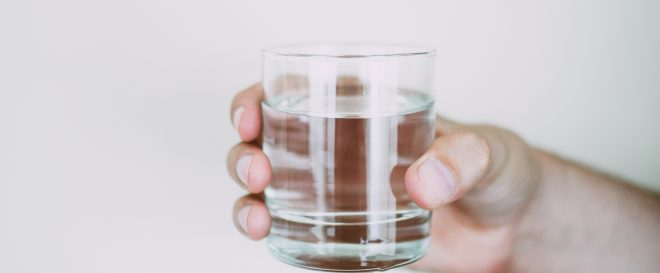The Truth About What’s Really in Tap Water

Drinking clean water is crucial for our health and survival, and for most people, their main source of hydration comes from the household tap. Sadly, not everyone in the world has the luxury of accessing clean, safe drinking water on tap; still, for many, it’s the norm, and typically taken for granted. While we are incredibly lucky to have an abundance of clean running water in our homes, we still must question just how ‘clean’ it actually is and whether there are additives or contaminants present that could impact our health.
Many people naturally assume that tap water is safe because of the government regulations that are supposedly in place to keep it so. While, to some extent, this may be true, tap water often does contain a number of contaminants that can be harmful to human health, which causes endless debate and ambiguity for consumers.
According to Lindsay McLain, VP Marketing at JUST Water, a company that focuses on sustainable water sourcing, drinking clean mountain spring water is essential for optimal health. McLain says, ‘Access to clean drinking water is a human right, and should be available to everyone on the planet; water without the contaminants commonly found in tap water is the safest option for optimal health.’
So, what exactly is in our tap water that can be harmful to our health?
Contaminants found in tap water
Chlorine
One of the most common contaminants found in everyday tap water is chlorine, which is used as a disinfectant to kill bacteria and other harmful organisms. While it makes the water safer to drink in some ways, chlorine can also react with other compounds present in the water to form ‘disinfection byproducts,’ which can be harmful. According to the National Library of Medicine, published reports have demonstrated an increased risk of developing colorectal cancers when exposed to chlorinated drinking water.
Fluoride
Another common additive in tap water is fluoride, which has long been a subject of controversy. Fluoride is added to water to help prevent tooth decay in the general population, which it is proven to be very effective at. Still, concerns surrounding its impact on human health remain a source of debate. High levels of fluoride can lead to a condition called dental fluorosis, which causes white spots to appear on the teeth. Over time, exposure to high levels of fluoride can also lead to skeletal fluorosis, a condition that causes joint stiffness and pain, although thankfully, this condition is rare.
The Environmental Protection Agency (EPA) regulates the quantity of fluoride in our drinking water to maintain what they deem to be safe levels, although some still believe that it should be eliminated. While some communities opt to supply fluoride-free water, the Centers for Disease Control and Prevention (CDC) estimate that around three-quarters of American homes have fluoride in their tap water.
Lead
Lead is a toxic metal that can be found in tap water due to old lead pipes and other plumbing fixtures. Exposure to lead can create a range of health problems, including developmental delays in children, high blood pressure, and kidney damage. In accordance with both the Safe Drinking Water Act and the EPA’s Lead and Copper Rule, steps have been taken in recent years to reduce the risk of exposure to lead via tap water, but if you are concerned, you can contact your local water authority for information and/or testing.
Pesticides and herbicides
Pesticides and herbicides are often used in agriculture to protect crops from pests and weeds. However, these chemicals can also end up in the water supply, either through runoff or by leaching into the soil. Lifetime exposure to pesticides and herbicides has been linked to a range of health problems, with research finding links with thyroid dysfunction, Parkinson’s Disease, female hormone disruption, and some cancers.
Pharmaceuticals
Pharmaceuticals are another concern when it comes to tap water. When people take medications, the drugs work their way through the body and are often then excreted in urine, ending up in the water supply. Many drugs are also flushed into waterways across the world, with a U.K. study finding that even shellfish can test positive for having antidepressants in their system.
The results of a U.S. Geological Survey testing 139 streams also discovered that 80% contained detectable chemicals, including active pharmaceutical compounds. While the levels of pharmaceuticals in tap water are typically very low, the long-term health-related effects of exposure to these chemicals are not yet fully understood.
Filter you water
While governments do regulate the quality of tap water and take measures to limit the presence of contaminants, many remain. Ultimately, no one can conclusively guarantee that your health will not be harmed in the short or long term by drinking tap water.
For this reason, many people choose to use water filtration systems in their home or place of work. There are a variety of filtration systems available, from simple pitcher filters to whole-house filtration systems, and a range of options in between. Water filtration systems can often remove a wide range of contaminants from tap water, including chlorine, fluoride, lead, and pharmaceuticals. If you’re on the lookout for a filtration system, it’s best to look for one that has been certified by a reputable organization, such as the National Sanitation Foundation or the Water Quality Association.
The bottom line
Tap water, while safe in many ways, can still contain a number of harmful contaminants that could have a negative effect on your and your family’s health. By understanding what’s really in our tap water and taking steps to protect ourselves, we can enjoy the benefits of clean, safe drinking water with complete peace of mind.
There’s no escaping the fact that drinking clean, safe water is essential for supporting our optimal health. Buying naturally and sustainably-sourced mountain spring water or installing a water filtration system in your home is a great way to ensure that your water is free from harmful contaminants. While the jury may be out as to just how harmful the contaminants present in tap water may be, it might be better to place the odds in your favor and stick to filtered or certified contaminant-free water.



